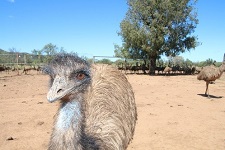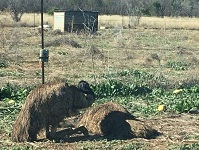Doctor Julia Ryeland
Candidature
Graduated PhD 2022
Thesis Title
Male parental care in the polyandrous emu, Dromaius novaehollandiae
Research Project
 The emblematic and endemic emu (Dromaius novaehollandiae) occurs throughout a wide range of habitats across the Australian continent, moving nomadically to areas of periodically high food availability and high rainfall events. Their numbers can greatly fluctuate regionally, both seasonally and annually and their clutches are high variable, producing many or few young each season. However, very little is known about their mating system or reproductive strategies in the wild. Socially monogamous pairs of emus are seen throughout the year, however females will often mate sequentially and simultaneously with multiple males in a season (a polyandrous mating system), resulting in clutches of both mixed paternity and maternity. The male bears the sole responsibility for incubation and the rearing of chicks; an uncommon trait in birds, particularly in a system where the male has low paternity assurance
The emblematic and endemic emu (Dromaius novaehollandiae) occurs throughout a wide range of habitats across the Australian continent, moving nomadically to areas of periodically high food availability and high rainfall events. Their numbers can greatly fluctuate regionally, both seasonally and annually and their clutches are high variable, producing many or few young each season. However, very little is known about their mating system or reproductive strategies in the wild. Socially monogamous pairs of emus are seen throughout the year, however females will often mate sequentially and simultaneously with multiple males in a season (a polyandrous mating system), resulting in clutches of both mixed paternity and maternity. The male bears the sole responsibility for incubation and the rearing of chicks; an uncommon trait in birds, particularly in a system where the male has low paternity assurance
The aim of this study is to elucidate what factors affect the male’s reproductive success in this uncommon male only parental care system. In attempt to better understand this, I aim to answer the following questions;
1) Are male emus face with a trade-off between mating with multiple females and the successful incubation his clutch?
2) Does clutch size effect hatchability and offspring fitness? Does this influence male mating strategies?
3) Does resource quality effect female investment in egg size and composition?
Finally, I will look at recruitment success and the likelihood of emus continuing to persist in the east of Australia, where their numbers appearing to be decreasing (despite their ability to produce many young per season). Through the monitoring of the reproductive success and population numbers of several east coast populations, I will be conducting species distribution modelling and population viability models to make recommendations of management needs for these emu populations.
Research Images



Awards/Honours
- Nomination for the 2017 British Ecological Society Haldane prize
- Birdlife Australia Stuart Leslie Bird Research Award Travel Grant 2017
- Joyce Vickery Research Fund recipient 2016
- Australasian Society for the Study of Animal Behaviour Conference 'Best short talk runners up' 2014
Publications
Derham T, Johnson C, Martin B, Ryeland J, Ondei S, Fielding M, Brook BW, (2023) 'Extinction of the Tasmanian emu and opportunities for rewilding' Global Ecology and Conservation, vol.41, Article no.e02358.
Davis S, Ryeland J, Smith SM, Hart G, Stow AJ, (2022) 'Divided by the range: evidence for geographic isolation of the highly mobile Emu (Dromaius novaehollandiae)', Emu-Austral Ornithology, vol.122, no.2, pp 87-99
Ryeland J, Magrath MJL, Weston MA, (2022) 'Day-night cycle influences the division of incubation in the Hooded Dotterel (Thinornis cucullatus)', Ibis, vol.164, no.3, pp 785-792
Rendall AR, White JG, Cooke R, Whisson DA, Schneider T, Beilharz L, Poelsma E, Ryeland J, Weston MA, (2021) 'Taking the bait: The influence of attractants and microhabitat on detections of fauna by remote‐sensing cameras', Ecological Management & Restoration, vol.22, no.1, pp 72-79
Ryeland J, Derham TT, Spencer RJ, (2021) 'Past and future potential range changes in one of the last large vertebrates of the Australian continent, the emu Dromaius novaehollandiae', Scientific Reports, vol.11, Article no.851
Ryeland J, House CM, Umbers KDL, Spencer R-J, (2021) 'Optimal clutch size and male incubation investment in the male-only incubating emu (Dromaius novaehollandiae)', Behavioral Ecology and Sociobiology, vol.75, no.12, Article no.168
Ryeland J, Weston MMA, Symonds MRE, (2021) 'The importance of wetland margin microhabitat mosaics; the case of shorebirds and thermoregulation', Journal of Applied Ecology, vol.58, no.2, pp 382-391
Umbers KD, White TE, De Bona S, Haff T, Ryeland J, Drinkwater E, Mappes J, (2019) 'The protective value of a defensive display varies with the experience of wild predators', Scientific Reports, vol.9, Article no. 463
Drinkwater E, Ryeland J, Haff T, Umbers KDL, (2017) 'A novel observation of food dunking in the Australian Magpie (Cracticus tibicen)', Australian Field Ornithology, vol.34, p 95
Ryeland J, Symonds MRE, Weston MA, (2017) 'Measurement techniques for curved shorebird bills: A comparison of low-tech and high-tech methods', Wader Study, vol.124, no.1, pp 49–54
Ryeland J, Weston MA, Symonds MRE, (2016) 'Bill size mediates behavioural thermoregulation in birds', Functional Ecology, doi:10.1111/1365-2435.12814
Supervisors
Associate Professor Ricky Spencer, Dr Kate Umbers & Dr Clarissa House